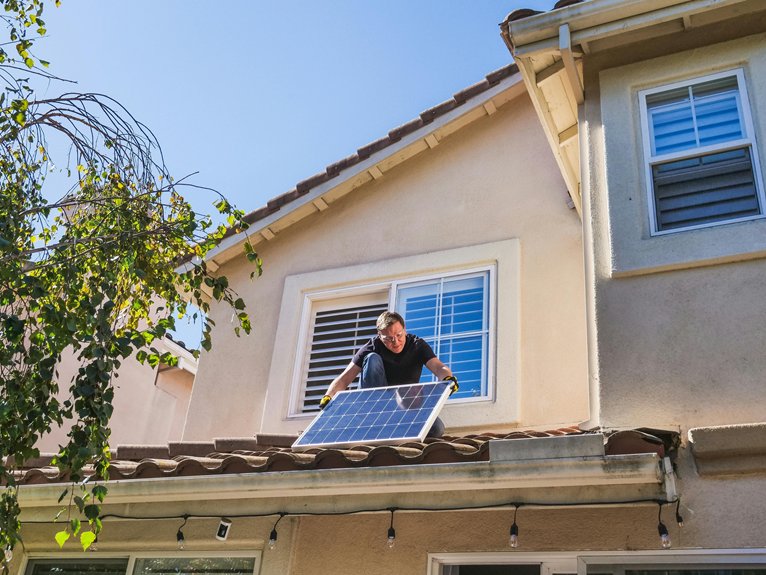Before replacing your roof in Edmond, it’s vital to have a professional inspection first. This step helps you understand the true condition of your current roof, catch hidden damages, and avoid unnecessary costs. Knowing what to look for can make a significant difference in your repair or replacement decisions. If you want to protect your home and investment, understanding the inspection process is a key place to start.
Understanding the Importance of Roof Inspections
Understanding the importance of roof inspections is crucial because they help identify potential issues before they become costly repairs. Regular roof maintenance relies on thorough inspections, which guarantee your roof stays in top shape. Conducting these inspections can also help you schedule appointments more efficiently and ensure timely repairs. An inspection checklist guides you through what to look for, including damaged shingles, leaks, or signs of wear. By conducting routine inspections, you catch minor problems early, preventing water damage and structural issues down the line. Skipping these checks often leads to unseen damage that worsens over time, increasing repair costs. Staying proactive with roof inspections allows you to schedule repairs efficiently, extend your roof’s lifespan, and maintain your home’s value. Don’t wait for visible problems—regular inspections are your best defense.
Signs That Indicate the Need for an Inspection Before Replacement
Recognizing the signs that your roof needs an inspection can save you from costly repairs or premature replacement. If you notice sagging or missing shingles, it’s time for an inspection.
Poor roof ventilation often leads to excessive heat and moisture buildup, causing damage that’s not always visible from the ground.
Additionally, misaligned gutters can indicate underlying issues with roof structure or drainage problems, which may signal the need for a professional check.
Water stains on ceilings or walls are also warning signs, as they suggest leaks that could worsen over time.
Addressing these issues early helps identify hidden damage and prevents small problems from escalating.
If any of these signs appear, scheduling an inspection ensures your roof remains in good condition and prolongs its lifespan.
What a Professional Roof Inspection Entails
A professional roof inspection involves a thorough examination of your roof’s overall condition, including the shingles, flashing, gutters, and attic. Using specific roof inspection techniques, the inspector carefully assesses for damage, wear, and potential leaks.
They follow an inspection checklist to guarantee no detail is overlooked, checking for cracked or missing shingles, deteriorated flashing, clogged gutters, and attic moisture. The process may include a visual inspection from the ground, a close-up roof walk, and interior evaluations of the attic space.
This systematic approach helps identify issues early, ensuring your roof’s integrity before replacement decisions. By relying on proven inspection techniques and a detailed checklist, professionals provide an accurate assessment of your roof’s current state.
Common Issues Detected During Roof Inspections
During a roof inspection, several common issues often come to light that can compromise your roof’s integrity. One frequent problem involves deterioration of the roof material, such as cracked or curling shingles, which weakens protection against the elements.
You might also notice damaged flashing or missing tiles, allowing water to seep in. Signs of moss, algae, or mold can indicate moisture buildup and reduced lifespan.
Additionally, the condition of gutters and drainage systems can reveal blockages or leaks that affect the roof’s performance. Regular inspections help catch these issues early, especially if you schedule them frequently, so minor problems don’t turn into major repairs.
Identifying these common issues ensures you maintain your roof’s durability and extend its lifespan before replacements become unavoidable.
Making Informed Decisions Based on Inspection Results
After identifying issues during a roof inspection, the next step is to interpret what these findings mean for your roof’s overall health and your home’s safety.
If damage is severe, it could impact your ability to file insurance claims or require repairs covered by your insurer. Understanding the extent of damage helps you decide whether to repair or replace your roof.
When making this decision, choose a reputable contractor who can provide honest guidance based on inspection results. They’ll help you evaluate the costs, benefits, and longevity of repairs versus full replacement.
Being informed allows you to prioritize safety and cost-efficiency, ensuring you make the best decision for your home and peace of mind.
Conclusion
Before replacing your roof in Edmond, a thorough inspection is crucial. It helps you identify hidden damages, assess the true condition of your roof, and make informed decisions. By working with a professional, you ensure that no issues are overlooked, saving you money and ensuring safety. Don’t skip this vital step—investing in a proper inspection now can extend your roof’s lifespan and prevent costly repairs later. For more information on how to schedule your free roof inspection, call us at (405) 543-2920 or visit us online at Top View Roofing.











